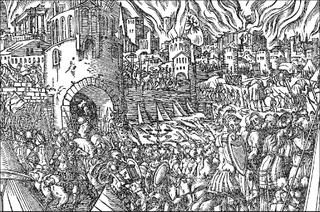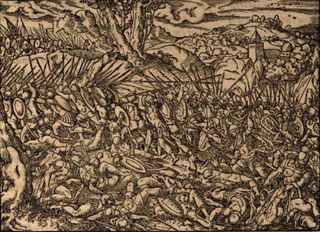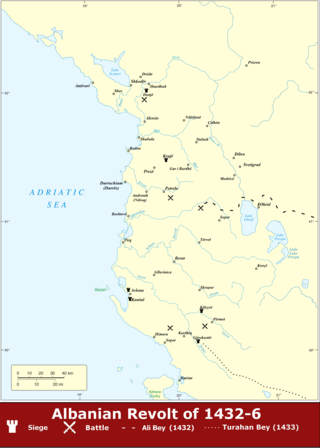
Mehmed II, commonly known as Mehmed the Conqueror, was twice the sultan of the Ottoman Empire from August 1444 to September 1446 and then later from February 1451 to May 1481.

The League of Lezhë was a military and diplomatic alliance of the Albanian aristocracy, created in the city of Lezhë on 2 March 1444. The League of Lezhë is considered the first unified independent Albanian country in the Medieval age, with Skanderbeg as leader of the regional Albanian chieftains and nobles united against the Ottoman Empire. Skanderbeg was proclaimed "Chief of the League of the Albanian People," while Skanderbeg always signed himself as "DominusAlbaniae".

The Battle of Albulena, also known as the Battle of Ujëbardha, was fought on 2 September 1457 between Albanian forces led by Skanderbeg and an Ottoman army under Isak bey Evrenoz and Skanderbeg's nephew, Hamza Kastrioti.

The Classical Age of the Ottoman Empire concerns the history of the Ottoman Empire from the conquest of Constantinople in 1453 until the second half of the sixteenth century, roughly the end of the reign of Suleiman the Magnificent. During this period a system of patrimonial rule based on the absolute authority of the sultan reached its apex, and the empire developed the institutional foundations which it would maintain, in modified form, for several centuries. The territory of the Ottoman Empire greatly expanded, and led to what some historians have called the Pax Ottomana. The process of centralization undergone by the empire prior to 1453 was brought to completion in the reign of Mehmed II.

The first siege of Krujë occurred in 1450 when an Ottoman army led by Sultan Murad II and his crown prince Mehmed II tried to besiege the Albanian town of Krujë. The League of Lezhë, led by Skanderbeg, experienced low morale after losing Svetigrad and Berat between 1448 and 1450. Nevertheless, Skanderbeg's exhortations and the support of the clergy, who claimed to have had visions of angels and victory, motivated the Albanians to defend the capital of the League, Krujë, at all costs. After leaving a protective garrison of 4,000 men under his trusted lieutenant Vrana Konti, Skanderbeg harassed the Ottoman camps around Krujë and attacked the supply caravans of Sultan Murad II's army. By September, the Ottoman camp was in disarray as morale sank and disease ran rampant. The Ottoman army acknowledged that the castle of Krujë would not fall by strength of arms, lifted the siege, and made its way to Edirne. Soon thereafter, in the winter of 1450–51, Murad died in Edirne and was succeeded by his son, Mehmed II.

The second siege of Krujë took place from 1466 to 1467. Sultan Mehmed II of the Ottoman Empire led an army into Albania to defeat Skanderbeg, the leader of the League of Lezhë, which was created in 1444 after he began his war against the Ottomans. During the almost year-long siege, Skanderbeg's main fortress, Krujë, withstood the siege while Skanderbeg roamed Albania to gather forces and facilitate the flight of refugees from the civilian areas that were attacked by the Ottomans. Krujë managed to withstand the siege put on it by Ballaban Badera, sanjakbey of the Sanjak of Ohrid, an Albanian brought up in the Ottoman army through the devşirme. By 23 April 1467, the Ottoman army had been defeated and Skanderbeg entered Krujë.

Gjergj Kastrioti, commonly known as Skanderbeg, was an Albanian warlord and military commander who led a rebellion against the Ottoman Empire in what is today Albania, North Macedonia, Greece, Kosovo, Montenegro, and Serbia.
The Battle of Vajkal or Battle of Valkal was fought in April of 1465 between the Albanian forces of Skanderbeg and an Ottoman army under Ballaban Pasha, an Ottoman commander of Albanian origin. Ballaban Badera, the new Ottoman sanjakbey of the Sanjak of Ohrid, was sent by Sultan Mehmed II to attack Albanian forces. The Albanians were ultimately victorious, but both sides suffered heavy losses. Some of Skanderbeg's officers were captured by the fleeing Ottomans and were then summarily executed.

The First Ottoman–Venetian War was fought between the Republic of Venice with its allies and the Ottoman Empire from 1463 to 1479. Fought shortly after the capture of Constantinople and the remnants of the Byzantine Empire by the Ottomans, it resulted in the loss of several Venetian holdings in Albania and Greece, most importantly the island of Negroponte (Euboea), which had been a Venetian protectorate for centuries. The war also saw the rapid expansion of the Ottoman navy, which became able to challenge the Venetians and the Knights Hospitaller for supremacy in the Aegean Sea. In the closing years of the war, however, the Republic managed to recoup its losses by the de facto acquisition of the Crusader Kingdom of Cyprus.

The Albanian–Venetian War of 1447–48 was waged between Venetian and Ottoman forces against the Albanians under George Kastrioti Skanderbeg. The war was the result of a dispute between the Republic and the Dukagjini family over the possession of the Dagnum fortress. Skanderbeg, then ally of the Dukagjini family, moved against several Venetian held towns along the Albanian coastline, in order to pressure the Venetians into restoring Dagnum. In response, the Republic sent a local force to relieve the besieged fortress of Dagnum, and urged the Ottoman Empire to send an expeditionary force into Albania. At that time the Ottomans were already besieging the fortress of Svetigrad, stretching Skanderbeg's efforts thin.

The siege of Svetigrad or Sfetigrad began on 14 May 1448 when an Ottoman army, led by Sultan Murad II, besieged the fortress of Svetigrad. After the many failed Ottoman expeditions into Albania against the League of Lezhë, a confederation of Albanian Principalities created in 1444 and headed by Skanderbeg, Murad II decided to march an army into Skanderbeg's dominions in order to capture the key Albanian fortress of Svetigrad. The fortress lay on an important route between present-day North Macedonia and Albania, and thus its occupation would give the Ottomans easy access into Albania.

Skanderbeg's Italian expedition (1460–1462) was undertaken to aid his ally Ferdinand I of Naples, whose rulership was threatened by the Angevin Dynasty. Gjergj Kastrioti Skanderbeg was the ruler of Albania who had been leading a rebellion against the Ottoman Empire since 1443 and allied himself with several European monarchs in order to consolidate his domains. In 1458, Alfonso V of Aragon, ruler of Sicily and Naples and Skanderbeg's most important ally, died, leaving his illegitimate son, Ferdinand, on the Neapolitan throne; René d'Anjou, the French Duke of Anjou, laid claim to the throne. The conflict between René's and Ferdinand's supporters soon erupted into a civil war. Pope Calixtus III, of Spanish background himself, could do little to secure Ferdinand, so he turned to Skanderbeg for aid.
On August 1465, Ballaban Badera, a sanjakbey of the Sanjak of Ohrid who was an Albanian-born janissary launched his fourth but largest campaign against Skanderbeg. He was defeated in both battles of Ohrid and Vajkal the year before. Ballaban had previously inflicted severe casualties on Skanderbeg's forces and soon received high favor from Mehmet II. He soon appointed Ballaban and Jakup Arnauti—both Albanian peasants by birth—to lead a joint-campaign against Skanderbeg's forces. According to some scholars, this act of inclusion by the Sultan was a promotion of a social revolution within Albania to wean forces away from Skanderbeg.
The Ottoman invasion of Albania in 1452 was a campaign by the newly acceded Ottoman sultan Mehmed II against Skanderbeg, the chief of the League of Lezhë. Shortly after the first siege of Krujë, Murad II died in Edirne, and was succeeded by his son Mehmed II. Mehmed ordered nearly annual invasions of Albania which often resulted in multiple battles in one year. The first of these expeditions was sent in 1452 under the dual command of Hamza Pasha and Tahip Pasha, with an army of approximately 25,000 men.
The Second Battle of Mokra occurred on July 7, 1462, right before Skanderbeg's Macedonian campaign. Sultan Mehmed II had come out of his recent campaigns victorious, adding large swaths of lands to his domains. He was confident enough to send a new force into Albania to weaken the Albanian forces. He thus sent an army under Sinan bey to complete the job. Skanderbeg had been prepared and moved towards the Albanian frontier. The armies came near Mokra where Skanderbeg had positioned his forces on a mountain dominating the landscape. When the Turkish force got near enough, the Albanians ambushed and the Turks routed. Skanderbeg then raided Macedonia and shared the loot with his men.

The Battle of Ohrid took place on 14 or 15 September 1464 between Albanian ruler Skanderbeg's forces and Ottoman forces. A crusade against Sultan Mehmed II had been planned by Pope Pius II with Skanderbeg as one of its main leaders. The battle near Ohrid occurred as a result of an Albanian incursion into Ottoman territory. The Ottomans stationed in the area were assaulted by Skanderbeg's men and 1,000 Venetian soldiers under Cimarosto. The Ottomans were lured out of their protections in Ohrid and ambushed by the Albanian cavalry. Skanderbeg won the resulting battle and his men earned 40,000 ducats after captured Ottoman officers were ransomed. Pius II died before the planned crusade began, however, forcing Skanderbeg to fight his battles virtually alone.
Turahanoğlu Ömer Bey was an Ottoman general and governor. The son of the famed Turahan Bey, he was active chiefly in southern Greece: he fought in the Morea against both the Byzantines in the 1440s and 1450s and against the Venetians in the 1460s, while in 1456, he conquered the Latin Duchy of Athens. He also fought in Albania, north-east Italy, Wallachia and Anatolia.
This timeline lists important events relevant to the life of the Albanian feudal lord and military commander Gjergj Kastrioti Skanderbeg, widely known as Skanderbeg.

The Albanian revolt of 1432–1436 was a series of conflicts between Albanian rebels and the Ottoman Empire during the early period of Ottoman rule in the region. Prompted by the replacement of large parts of the local nobility with Ottoman landowners, centralized governance, and the Ottoman taxation system, the population and the nobles, led principally by Gjergj Arianiti, revolted against the Ottomans.

The Albanian-Ottoman Wars (1432–1479) were a series of wars and revolts against the rising Ottoman Empire by Albanian feudal lords. The wars and revolts took place in present-day Albania, Montenegro, Kosovo, North Macedonia and South Serbia. In this period, Albanians under the leadership of Gjergj Arianiti and especially later under Skanderbeg resisted the Ottomans under two Sultans in over 30 battles. Skanderbeg continued this resistance until his death in 1468, and the Albanians persevered for another 11 years before being defeated.













